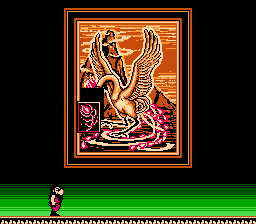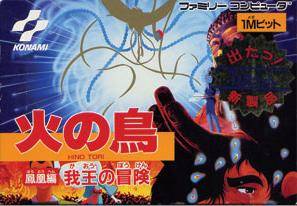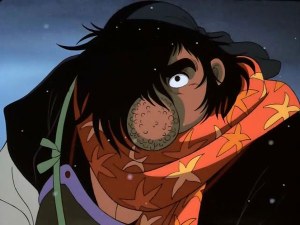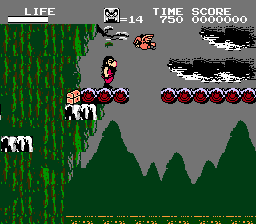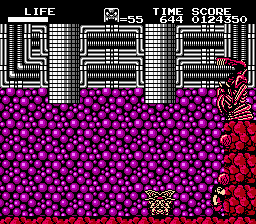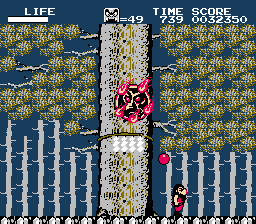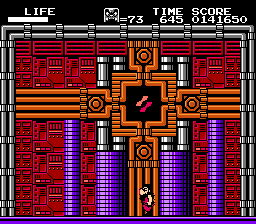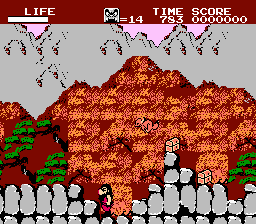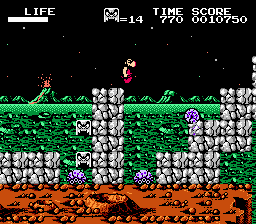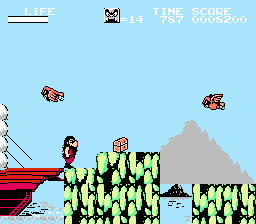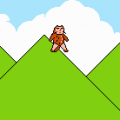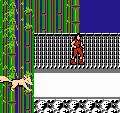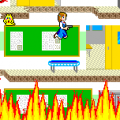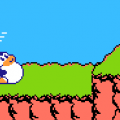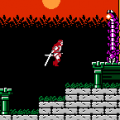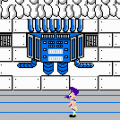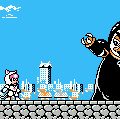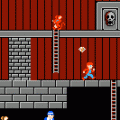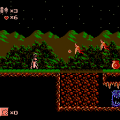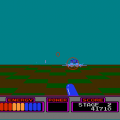- Hi no Tori Hououhen: Gao no Bouken
- Hi no Tori Hououhen
Hi no Tori Hououhen is the fifth volume of the famous manga by Osamu Tezuka, which initially began in 1987. (“Hi no tori” literally means “fire bird”, while “hououhen” means “Phoenix edition”). Konami developed two games, both published in 1987, based on the series, though they both take substantial liberties with the source material. The NES game is a side-scroller, with the MSX2 game is a vertical shoot-em-up. Both were released around the same time as an anime movie based on the same chapter.
Both games tell the story of Gao, a one armed man who was once a merciless bandit who killed and plundered at his whmim, but a single event changed him forever when he killed his wife out of a misunderstanding. There’s also another character in the manga, Akanemaru, who had carved a great phoenix, which had served as the central piece of this story. But since he’s more of an artist type and really wasn’t suited to action games, Gao was changed to the main character and a few things changed around to make him the focal point.
To atone for his ways, he began to travel the land as a monk, crafting gargoyles. One day, the Emperor decrees: “find me one who can carve the Phoenix.” And so Gao creates his masterpiece, but it’s stolen by someone and shattered into 16 pieces. And so Gao’s quest is to get these fragments back and reassemble it. For those that haven’t read the manga, Gao never carved the Phoenix or was ordered to do any such thing. It’s actually another character, Akanemaru, who carved the Phoenix. But that character isn’t really suited for an action game because he’s more of an artist type. So that’s why a few things were embellished and transposed onto Gao as a basis for the game.
On that note, there is little-to-no text or story in the games themselves. The Karma volume and all other Phoenixvolumes are incredibly complex stories that span massive periods of time and feature a multitude of characters and events. It would be almost impossible to cram all that into one NES game given the limitations of the hardware. It’s almost as if the developer’s decided it was impossible to adapt the story and just did whatever they wanted with it.
The Famicom Hi no Tori games might use Gao’s story, Hououhen, as its basis, but it also connects to three of the other volumes: Dawn, Future, and Yamato (the first, second, and third, respectively) through time travel. You start off in Yamato for six stages, warp to Dawn for three, warp to Future for six, and warp back to Yamato for the final stage. At the end of each stage, there’s usually a boss or puzzle awaiting you. Afterwards, you’ll get a piece of the Phoenix and move onto the next stage. These are your typical hallmarks of platform games, but Gao no Bouken is all about going in circles. For example, once you beat the sixth stage of Yamato, you are sent back to the beginning of the game. You haven’t actually beaten the game yet, of course. As it turns out, there’s actually a number of hidden portals that will criss-cross back and forth between worlds until you reach the final stage.
Gao’s main weapon is throwing spears. He can also do a ground stomp by jumping and then pressing down as you land, which can destroy various terrain and reveal hidden stuff like those portals. Gao can also sculpt gargoyles by pressing Down + B, which you can use to platform your way across a stage and access remote areas. Unfortunately, the control scheme is a little awkward mostly due to the NES’ limited controller. Because of this, you can’t throw spears while ducking, but you can throw spears vertically. Getting used to creating gargoyles can be quite tricky when you have materialize them in mid-air beneath a pit. If you mess up, you’ll die. Gao’s movement is also awkward because he slides for a short length, which makes it easy to careen off the edges of platforms. In the Dawn world, there’s an ice stage that only exacerbates this issue.
You only have a limited number of gargoyles at your disposal, but the game gives you a chance at gaining more of them through fallen enemies. As they die, they become gargoyles that slide along the ground that you can grab. Though you’ll lose your chance if they fall into a pit or hit a wall, which at that point, they turn to stone. Each stage also has treasure chests with power ups that you can open by throwing spears at. Sometimes they even fall from the sky and you need to hit them mid-air, or else you’ll lose them.
There are a few connections to the manga, at least. The end of each stage features a screen where a picture of the Phoenix is gradually completed as you gain more pieces. Once it’s completed, it becomes a recreation of a painting that was in the manga. Some of the enemies like the bald monks and bandits also look closest to something in the manga. While the rest are mostly mythological creatures, which was something the manga was not known for at all aside from the actual Phoenix. The only exception to this was the last volume of the manga which took a more mythological approach to its story.
The early stages in Yamato look pretty odd and make you wonder if the game isn’t bugged. The design tends to get better and better as you progress though the game. The Future stages in particular looks quite striking, with a wonderful range of darker colors, distant planets, twinkling stars and godly statues. It feels kind of cosmic. You end up battling a super computer, which when defeated reveals a Konami logo. Logo aside, that’s actually somewhat faithful to the manga because in the Future volume, the world is destroyed by two opposing super computers. When do you finally find your way to the final stage, you’re back to Yamato in the middle of a volcanic eruption. It’s nicely detailed, featuring lots of reds, earthy browns and a shaking screen. While not particularly striking, the music is also fairly typical of Konami during the time. A few of tracks have an Asian influence, which is fitting since a lot of Phoenix took place in medieval Japan. One of the composers was Hidenori Maezawa, who was one Konami’s most prolific composers.
With its time traveling theme, Gao no Bouken doesn’t really convey the themes of the manga, and the awkward controls make the game somewhat difficult to play. But the non-linear design is very different from any platformer of the era, and a welcome twist that completely changes the experience.
